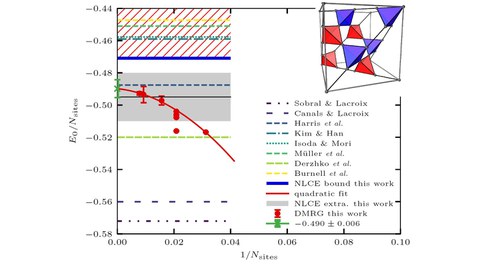Mar 25, 2021
Research: Possible Inversion Symmetry Breaking in the S=1/2 Pyrochlore Heisenberg Magnet

The figure shows various predictions of the ground-state energy of the pyrochlore lattice (inset) per site (horizontal lines) from different approaches. Our energy estimation from the DMRG calculation is given for different cluster sizes (red dots) and extrapolated to the thermodynamic limit. We are also able to assign a strict upper bound (red dashed area) for the ground-state energy at zero temperature from a systematic cluster expansion at finite temperature.
Frustrated materials, like the quantum pyrochlore magnet, continue to pose challenges for the condensed matter physics community and many questions remain unanswered. Anti-ferrmomagnetic couplings on the bonds of the tetrahedral unit cell induce strong geometrical frustration. The system is not able to satisfy all competing exchange couplings simultaneously potentially giving rise to exotic low energy physics.
In our work, we address the extreme quantum limit, S=1/2, of such a pyrochlore anti-ferromagnet using extensive state-of-the-art computational studies revealing new insights in the zero temperature structure of the model. By using SU(2) density-matrix renormalization group, we are able to access cluster sizes of up to 128 spins for the first time. Hence, we determine an accurate estimation of the ground-state energy per site in the thermodynamic limit, E=−0.490(6)J, where J is the coupling constant.
Crystal structures exhibit several symmetries, among others the three-dimensional pyrochlore preserves the inversion symmetry. Analyzing the ground-state structure we found strong evidence for a robust spontaneous inversion symmetry breaking in the ground state. This finding conflicts with earlier assumptions of a symmetric “spin-liquid” like ground-state.
I. Hagymási, R. Schäfer, R. Moessner, D. J. Luitz,
Possible Inversion Symmetry Breaking in the S=1/2 Pyrochlore Heisenberg Magnet,
Phys. Rev. Lett. 126, 117204 (2021) (arXiv)
